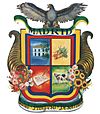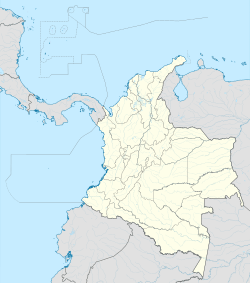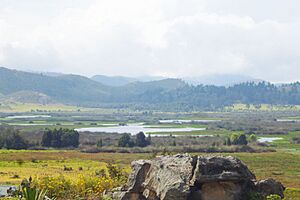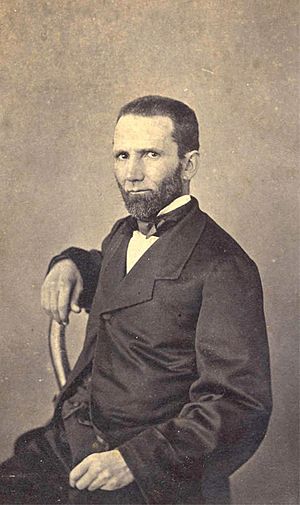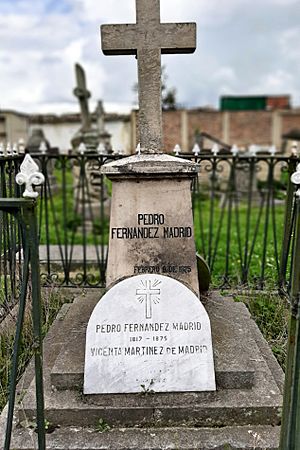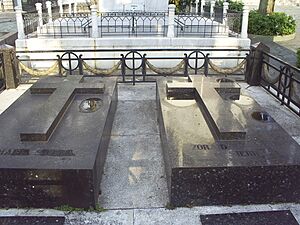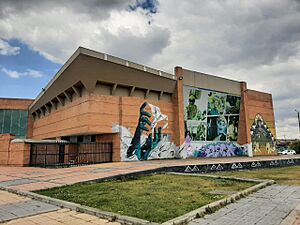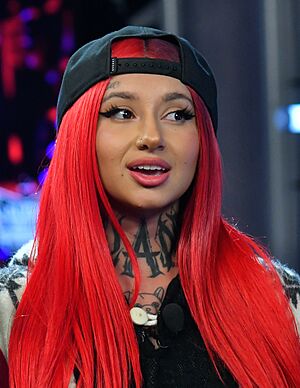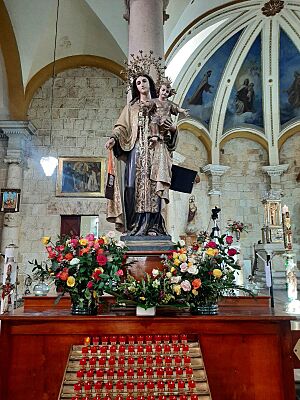Madrid (Colombia) facts for kids
Quick facts for kids
Madrid
|
|||
|---|---|---|---|
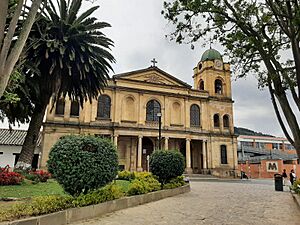
Church San Francisco de Paula
|
|||
|
|||
| Motto(s):
Unity - Progress - Development
|
|||
| Anthem: Anthem of Madrid | |||
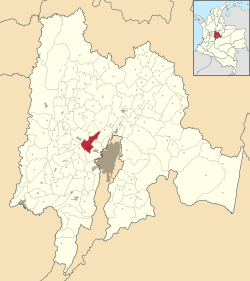
Location of the municipality and town of Madrid in the Cundinamarca Department of Colombia
|
|||
| Country | |||
| Department | |||
| Province | Western Savanna Province | ||
| Founded | November 20, 1559 | ||
| As a municipal district | 1834 | ||
| Founded by | Alonso Díaz | ||
| Named for | Pedro Fernández Madrid | ||
| Area | |||
| • Municipality | 120.5 km2 (46.52 sq mi) | ||
| Population
(2024)
|
|||
| • Municipality | 200,000 | ||
| • Density | 1,700/km2 (4,300/sq mi) | ||
| • Urban | 132.214 | ||
| Demonym(s) | Madrilenian, madrileño, -ña | ||
| Time zone | UTC-5 | ||
| Area code(s) | 60+1 | ||
| Website | www.madrid-cundinamarca.gov.co/ | ||
Madrid is a town in the department of Cundinamarca in Colombia. It is one of 116 towns in this area. Madrid is part of the Western Savanna Province.
About 200,000 people live here as of 2024. This makes it one of the most populated places in the region. Madrid covers 120.5 square kilometers. It sits at an altitude of 2,554 meters (8,379 feet) above sea level. The town is only 21 kilometers (13 miles) from Bogotá. This close distance means it's an important part of Bogotá's Metropolitan Area.
Madrid was first started in 1559 by Alonso Díaz. It was called La Serrezuela back then. In 1875, its name changed to Madrid. Today, Madrid is known for its many homes and diverse culture. It's a key commuter town for people working in Bogotá. This shows how cities grow and how people move around in Colombia.
Many important people in Colombian history have lived or worked in Madrid. These include Jorge Miguel Lozano, Marquis of San Jorge, a very influential person. Also, Simón Bolívar, the great Liberator, and Antonio Nariño, who helped start the independence movement. José María Vergara y Vergara, a famous writer, and Rufino José Cuervo, a language expert, also lived here. Pedro Fernández Madrid, a well-known politician, made big contributions. Later, Rafael Reyes helped modernize the country. Alfonso López Pumarejo, a president who brought many changes, also shaped the town's history.
Contents
What's in a Name?
The name Madrid was chosen to honor Pedro Fernández Madrid. He was born in Havana, Cuba. He spent his last years in the town once known as La Serrezuela. After he passed away in 1875, people asked to rename the town. This request was approved on November 17, 1875. This way, Fernández Madrid's legacy became part of the town's name.
The name Serrezuela means "Small Mountain Range." It was used again in 1945. But then it changed back to Madrid in 1946. In 1973, the original name was brought back. This was to follow a law that said towns should have native or historical names. However, the name Madrid was officially set again on November 16, 1976. Historian Roberto Velandia said the name Madrid was chosen because people liked Pedro Fernández Madrid so much.
The name Madrid has an interesting link to the capital of Spain. Madrid, Spain, got its name from an old stream. This stream flowed through what is now Segovia Street. Our Madrid, Colombia, is named after Pedro Fernández Madrid. But it also has the Subachoque River flowing through it. This connection shows how rivers and mountains can influence place names. The old name of the Colombian town, La Serrezuela, meant a small mountain range. It referred to the Tibaytatá hill.
People who live in Madrid are called madrilenian (or madrileño and madrileña in Spanish).
Madrid's Long History
Ancient Times
In March 2003, during construction in Madrid, an amazing archaeological site was found. This site showed a special place for rituals and burials. It also seemed to be used for watching the stars. Unique pottery found there dates back to Colombia's Herrera period.
The site is similar to another one in Soacha. Skeletons were found lying on their sides with bent limbs. Their skulls were long, and their teeth showed certain wear. Pottery from the Herrera and Magdalena River Valley regions was found. Also, stone tools and animal bones were present. This suggests people first lived here around 1000 B.C.
Later, around 1 A.D., another group lived here. They used Herrera pottery and focused more on agriculture. These people had rounder skulls. They built a special place for rituals and astronomy. It had a channel over 30 meters long. It had circular shapes on one side and square shapes on the other.
The river in Madrid has had many names. In the Muisca language, it was called Chacha or Chinga. This means "twice male." Later, it was called Serrezuela and then Subachoque. This river meets the Bojacá River at a place called Balsillas. They form the La Herrera lagoon. From there, the river flows into the Bogotá River.
The La Herrera lagoon has always been rich in plants and animals. It provided food for hunters, gatherers, and early farmers. The lagoon and rivers offered birds, guinea pigs, fish, and small mammals. Wild animals like deer from the hills were also available. For thousands of years, people here relied on hunting, gathering, and fishing.
Studies of the soil in the Bogotá savanna show that the Madrid site was once a lake area. It had the La Herrera lagoon and big wetlands. The Subachoque River flowed into the lagoon. This covered a large part of the western plateau.
Many water bodies were present in the region for a long time. Even with all this water, people lived and thrived around them. Soil evidence shows early settlements on the lake shores. People built their homes on stilts over the water.
Archaeological findings also show periods of drought. This happened especially around 1000 B.C. Fireplaces were found under layers of white clay, which was the lakebed. This shows how early people adapted to changing weather in the Cundiboyacense high plateau.
Spanish Arrival
When the Spanish arrived, they found a Muisca village led by a chief named Sagasuca. The Spanish renamed it Pueblo de indios de Sagasuca. On November 20, 1559, Alonso Díaz officially founded the town. He named it La Serrezuela because it was near a hill. During the Spanish era, Spanish families settled here. They started encomiendas, which were land grants with native labor.
Important officials, archbishops, and viceroys often passed through La Serrezuela. They sometimes stayed overnight. This was because the town was on the main route from old Santafé to Honda.
In 1639, a chief named Don Juan from Tybaitatá was important in the settlement. At that time, the population included Spaniards, indigenous people, criollos, and mulattos.
In 1774, a Spanish law ordered the reorganization of native towns. La Serrezuela was almost closed down. This was because it was poor and had few people.
The Bridge of the Spaniards is a famous old bridge built in 1789. It was designed by an Italian engineer, Domingo Esquiaqui. It crosses the Subachoque River and is still used today. This bridge is the oldest building in Madrid. It is also one of the oldest in the Cundinamarca department. In 1789, about 70 residents and 70 indigenous people lived in the town.
During this time, rich families from Santafé owned large farms called haciendas. Some of these farms later belonged to or were visited by famous historical figures:
- La Hélida: Jorge Miguel Lozano, Marquis of San Jorge, lived here.
- El Boyero: Owned by Rufino José Cuervo, a famous Colombian scholar.
- La Estancia: This farm belonged to the Serrano Escallón family. Antonio Nariño hid some of his writings here. This included his translation of the Declaration of the Rights of Man and of the Citizen. Nariño hid at La Estancia after being chased for working against the Spanish government in 1792.
- Casablanca: Owned by José María Vergara y Vergara. He wrote parts of his book History of Literature in New Granada here. Simón Bolívar also stayed overnight in one of its rooms. Later, it was owned by José María Sierra, who became the richest man in Colombia.
- San Marino: This farm is named after the country San Marino. It started in the late 1800s. Rafael Reyes, a former president, often visited. Alcira and Lucila Blanco, friends of President Alfonso López Pumarejo, lived here. They named it Hacienda San Marino after surviving World War II.
- Casa de Santa Inés: This farm on Occidente Road had offices for early airlines. These included Transportes Aéreos Centroamericanos (now Avianca).
Modern Times
19th Century
In the 1800s, Madrid saw many battles. These were fought by armies trying to gain freedom. José Hilario López, a military leader and president, set up his base in Madrid in 1831.
In 1881, General Tomás Cipriano de Mosquera, who later became president, led an uprising in Madrid. In 1894, there was another rebellion. This one was against the rule of José María Melo. Melo was the president during the civil war of 1854.
In the late 1800s, Rufino Gutiérrez wrote a book called Monografías. He described Madrid and other towns. He said Madrid was in a bad and poor state. There were two public schools, one for boys and one for girls. There was also a private school. The town had a public slaughterhouse, a telegraph office, and a tax office.
Gutiérrez said Madrid had 11 blocks and 9 streets. It had 70 homes, with 22 having clay-tiled roofs. The town also had important public buildings. These included a church, a town hall, a parsonage, the two schools, a cemetery, and a railway station. The railway station was built in 1882.
Two important businesses were also started then. Julián Escallón ran a wheat mill. General Antonio Basilio Cuervo owned a brewery. The wheat mill used water from the Subachoque River. It made carts and machines for pressing animal feed. Basilio Cuervo's brewery sold beer from the Savanna to distant places like La Mesa and Honda.
Rufino Gutiérrez also described the social classes of that time. He said the rich landowners didn't care about the town's progress. Smaller landowners were jealous of the rich and looked down on those below them. He felt the native people lacked community spirit.
Pedro Fernández Madrid's Legacy
During these years, Pedro Fernández Madrid lived in La Serrezuela. He was born in Havana, Cuba, on December 13, 1817. He passed away on February 8, 1875. His father, a hero of independence, was in exile in Cuba when Pedro was born. Pedro studied there until 1825. Then he returned to Cartagena with his family. In 1826, he went to France and London with his father. His father was a diplomat there. Pedro got a good education from Andrés Bello, who worked for the Colombian Legation. After his father died in 1830, Pedro went to university. He became a lawyer in 1838. He started writing in 1837, defending his father.
In 1842, he published Treatise on Public Instruction. In 1843, Pedro joined the Ministry of Foreign Affairs. He helped define national borders and relations with the Holy See. From 1852 to 1860, he was a congressman. He was president of the congress in 1857. He also served the Boyacá State and was a member of the National Academy of History. Due to health problems, he left politics in 1864. He moved to La Serrezuela with his wife, Vicenta Martínez de Madrid. They bought a house there to rest. They had four children: Rosalía, Alejandrina, Pedro Vicente, and Camilo. It is said that one of their daughters drowned near the old Parque de las Ballenitas.
In his later years, Pedro lived with his wife and housekeeper, Tránsito Ospina. Tránsito gave her life trying to save Mrs. Vicenta. Sadly, both drowned in the Subachoque River. Pedro Fernández Madrid is remembered as a leader, writer, and teacher. His remains, along with his wife's and housekeeper's, are in Madrid's cemetery. The people of La Serrezuela felt honored by Pedro's love for their town. This led them to rename it Madrid on November 17, 1875.
20th Century
In 1900, a rich businessman from Antioquia, José María Sierra, bought Hacienda Casablanca. He was known as Pepe Sierra. He was one of Colombia's wealthiest men. He lived there with his wife, Zoraida Cadavid de Sierra, and their thirteen children. When Zoraida died in Paris in 1921, her will said that part of their money should create a home for poor girls in Colombia. This led to the Zoraida Cadavid de Sierra Asylum. It was first in Bogotá. But in 1945, his daughter María Sierra moved it to Madrid. With her grandson Guillermo Gómez Sierra, it became the Zoraida Cadavid de Sierra Institute School.
To do this, María bought an old mansion that belonged to President Rafael Reyes. It was torn down to build the school.
President Rafael Reyes lived in Madrid during his time as president, from 1904 to 1909. He was the first president to serve longer than the usual four years. He resigned because of public and political pressure.
In the early 1900s, Pedro Aquilino López and his wife, Rosario Pumarejo de López, rented an old house near Pedro Fernández Madrid Park. They stayed there while traveling from Honda to Bogotá. Their son, who later became President Alfonso López Pumarejo, was with them. A statue of him was once in the park by the Subachoque River. Sadly, this statue was stolen.
In 1973, Mayor Marina Camacho de Samper asked to change the town's name back to Serrezuela. This was to follow a law from 1920. This law suggested using native or historical names for towns. But finally, on November 16, 1976, the town was officially named Madrid again.
Neighboring Towns
What is Madrid's Weather Like?
Madrid has a mild, steady climate. This means temperatures don't change much throughout the year. Temperatures usually stay between 7°C (45°F) and 20°C (68°F). The average temperature is 14°C (57°F). This is because of its high elevation and location near the equator.
| Climate data for Madrid (Base Aerea Madrid), elevation 2,550 m (8,370 ft), (1981–2010) | |||||||||||||
|---|---|---|---|---|---|---|---|---|---|---|---|---|---|
| Month | Jan | Feb | Mar | Apr | May | Jun | Jul | Aug | Sep | Oct | Nov | Dec | Year |
| Mean daily maximum °C (°F) | 18.9 (66.0) |
19.3 (66.7) |
18.7 (65.7) |
18.7 (65.7) |
18.6 (65.5) |
18.4 (65.1) |
18.4 (65.1) |
18.4 (65.1) |
18.6 (65.5) |
18.2 (64.8) |
18.4 (65.1) |
18.7 (65.7) |
18.6 (65.5) |
| Daily mean °C (°F) | 13.5 (56.3) |
13.6 (56.5) |
13.8 (56.8) |
14.0 (57.2) |
14.1 (57.4) |
13.9 (57.0) |
13.8 (56.8) |
13.8 (56.8) |
13.8 (56.8) |
13.8 (56.8) |
13.8 (56.8) |
13.6 (56.5) |
13.8 (56.8) |
| Mean daily minimum °C (°F) | 5.3 (41.5) |
5.4 (41.7) |
6.7 (44.1) |
7.7 (45.9) |
7.7 (45.9) |
7.0 (44.6) |
6.4 (43.5) |
6.4 (43.5) |
6.1 (43.0) |
6.8 (44.2) |
7.0 (44.6) |
5.3 (41.5) |
6.5 (43.7) |
| Average precipitation mm (inches) | 14.1 (0.56) |
29.3 (1.15) |
41.8 (1.65) |
73.9 (2.91) |
72.2 (2.84) |
49.7 (1.96) |
38.8 (1.53) |
36.3 (1.43) |
42.7 (1.68) |
74.2 (2.92) |
64.5 (2.54) |
30.0 (1.18) |
567.5 (22.34) |
| Average precipitation days | 6 | 9 | 12 | 15 | 17 | 14 | 13 | 12 | 12 | 16 | 14 | 8 | 136 |
| Average relative humidity (%) | 79 | 80 | 81 | 82 | 82 | 81 | 80 | 79 | 80 | 82 | 82 | 81 | 81 |
| Mean monthly sunshine hours | 189.1 | 158.1 | 139.5 | 111.0 | 111.6 | 120.0 | 136.4 | 139.5 | 132.0 | 130.2 | 126.0 | 167.4 | 1,660.8 |
| Mean daily sunshine hours | 6.1 | 5.6 | 4.5 | 3.7 | 3.6 | 4.0 | 4.4 | 4.5 | 4.4 | 4.2 | 4.2 | 5.4 | 4.6 |
| Source: Instituto de Hidrologia Meteorologia y Estudios Ambientales | |||||||||||||
How Many People Live in Madrid?
Madrid has a high population density in its urban areas. There are about 900 people per square kilometer. In rural areas, there are 50 to 75 people per square kilometer. The population is growing by 5.6% each year. This is mainly because many people are moving from Bogotá. About 136,374 people live in Madrid's urban areas.
What is Madrid's Economy Like?
Madrid has a varied economy. It includes businesses, agriculture, livestock farming, and industry.
Businesses are very important in Madrid. There are many shops and services for both locals and visitors.
Agriculture plays a big role. Madrid has fertile land and good weather for growing crops. These include fruits, vegetables, grains, and beans. Livestock farming is also important. Many dairy and meat animals are raised here.
Manufacturing is a major part of Madrid's economy. Many companies produce goods and services. These range from electronics to food and chemicals. Madrid is known for its strong industrial growth. This is along the Carretera de Occidente, which connects Bogotá and Facatativá. Its location in the Puente de Piedra area is also key. This area links the northern and southern parts of the town and region.
Madrid is Colombia's top flower-growing town. It is also one of the world's leading producers of cut flowers. Over 1,000 hectares are used for growing flowers. The town has major flower companies like Fantasy Flowers and Jardines de los Andes. However, growing flowers can affect the environment and health. A study by SciELO shows that greenhouse flower production can use up natural resources. This includes deforestation, using chemicals, and creating waste. Also, workers can be exposed to chemicals, which can be a health risk.
Fun Things to Do in Madrid
Obleas Villetica
The historic Obleas Villetica shop is famous for its delicious obleas. Obleas are thin, sweet wafers. This shop has been delighting people for over 122 years. It is located at 7th Street and 4th Avenue, across from Luis Carlos Galán Park.
Madrid's Culture
Literature
Pedro Fernández Madrid's Writings
Besides his political work, Pedro Fernández Madrid was also a famous writer. In 1842, he published his most important work, Pamphlet on Public Instruction. It won a gold medal in a competition. Through his writings, he strongly supported Colombia's rights. He helped ensure that Colombia's borders were recognized by the United Kingdom and the United States. His writings also led to new laws about population and immigration.
In 1871, Pedro Fernández Madrid became a member of the Colombian Academy of Language. This recognized his important contributions to literature. It also honored his strong defense of Colombia's rights.
Music
Kei Linch: A Rising Star
Karla Cajamarca, known as Anarkía Kei Linch, is a talented young rapper, musician, and singer-songwriter from Madrid. She started her career in Bogotá's underground rap scene. In 2021, Anarkía became famous across Colombia. She was a finalist in the fourth season of the El Factor X TV show. She is inspired by artists like Tres Coronas and Canserbero. Anarkía released her first EP, "Red & Blue Sad Doll," using YouTube tracks.
In 2020, during the COVID-19 pandemic lockdown, Anarkía joined the Caciques project. This project looked for new hip-hop talent in Colombia. Anarkía showed her talent and strong character. She became a potential leader in the movement. She also shared her hometown, Madrid, Cundinamarca. She thanked those who helped her achieve her dreams.
Even though she didn't win El Factor X, Anarkía impressed rap and hip-hop fans. This was during her final performance on May 30, 2021.
Religion
San Francisco de Paula Church
The church's history began on September 23, 1635. Church records show the baptism of an indigenous child named Mateo. At that time, the church was called the Parish of La Serrezuela.
Construction of the current San Francisco de Paula Parish Church started on August 15, 1895. This was thanks to the hard work of the clergyman Sandalio María Rodríguez.
Since it was built, the parish has been active in religious work. Records show that in 1635, the first baptism took place. This was under the parish priest Juan Bautista Guio Cerullo. Cerullo continued his duties until 1655.
The current church building was blessed by the Archbishop of Santa Fe on August 15, 1895. Parish priest Sandalio María Rodríguez carefully oversaw its construction. The church is made of stone from Chunuba de Bojaca. It is dedicated to the Most Holy Virgin Mary.
Julio Sánchez González: The Priest
Julio Sánchez González, known as El cura Julio (Father Julio), was born in Madrid in 1914. He lived there until he was 14. Then he entered the seminary to become a priest. He became a priest in Rome. He always cared about education. He worked as a chaplain at Gimnasio Moderno and Colegio Alfonso Jaramillo. In 1966, he founded the Colegio Emilio Valenzuela. His guiding idea was: "We don't want to be just another school. Our ideal must always be clear, and its spirit vibrant and fervent: we shall not allow ourselves to be worn down by time, corroded by routine, or destroyed by inertia." A year later, he became the rector and served until 2001.
Julio was good friends with members of the Golconda group. These included Camilo Torres Restrepo and René García Lizarralde. This was despite their different ideas. Julio passed away in Bogotá in 2009.
Madrid's Role in Defense and Security
The School of Radiotelegraphy and Mechanics was created on July 5, 1932. Its main base was at the Aerospace Base in Madrid. After training 14 groups of aviation mechanics, the school moved to Cali in 1953. There, its courses were expanded. On January 1, 1970, the school returned to Madrid. It got new facilities and was renamed the School of Non-Commissioned Officers Captain Andrés María Díaz Díaz. So far, it has graduated 92 groups of non-commissioned officers.
In 1991, the school was allowed to offer five technology programs. These programs last six semesters. Students who complete them become aeronautical technologists. In 2006, the Ministry of National Education approved these programs. They were accredited for four years with high ratings:
- Technology in Aeronautical Maintenance (Rating: 3.98)
- Technology in Airport Security (Rating: 5.0)
- Technology in Aeronautical Communications (Rating: 4.1)
- Technology in Aeronautical Supplies (Rating: 4.2)
- Technology in Aeronautical Electronics (Rating: 4.7)
These programs show the school's excellence in aeronautical studies.
The Air Maintenance Command is a unit of the Colombian Aerospace Force. It was created on November 8, 1924. Its operations started at the Serrezuela estate in Madrid. An advisory team from the Swiss Air Force helped at the beginning.
The unit temporarily closed on December 28, 1928, due to problems. But in 1929, it reopened. Lieutenant Colonel Arturo Lema Posada and Lieutenant Camilo Daza returned to the country. They were the first Colombian instructors. The unit was known as the School of Piloting and Observation before moving to Cali. In 1943, the Aerial Instruction Center for civilian pilots was set up. Its first class graduated on July 29, 1944. Later, the unit focused on training non-commissioned staff. It became the Base School of Technical Classes. As the Colombian Air Force grew, the 101st Military Air Transport Squadron was formed. The unit became the Transport Base. In 1956, it became the Arsenal Base. It was in charge of providing supplies for aircraft and war materials. Later, it became the Air Material Command. It included maintenance and supply groups. After the supply group moved, the unit became the Air Maintenance Command.
Since 1971, a big program of construction and workshop upgrades has been done. New, modern equipment was added. This has helped create a strong aviation industry. It serves both the Aerospace Force and commercial aviation in Colombia. On May 31, 2002, the Air Maintenance Command received a special certificate. This allowed it to offer services to private aviation in Colombia.
Throughout its history, 58 officers have led the command. Their hard work has made the Air Maintenance Command a key part of aviation maintenance in Colombia.
Famous People from Madrid
Rafael Navas Pardo was born in Madrid, Cundinamarca, on February 2, 1908. He became an important figure in Colombia's military and politics. Navas Pardo was a key member of the Junta Militar de Gobierno. This group replaced General Gustavo Rojas Pinilla from May 10, 1957, to August 7, 1958. He studied at Colegio de La Presentación and Instituto de la Salle de Bogotá. He became a subofficer from the Escuela de Suboficiales. Then he joined the Escuela Militar de Cadetes, becoming a sublieutenant in 1933.
During his military career, Navas Pardo served in many units. These included the Escuela Militar de Cadetes and the Batallón Guardia de Honor. He held various positions. He was a military mayor, commander of military units, head of the Bogotá Police Division, and commander of the Military Institutes Brigade. This shows his wide-ranging career.
General Navas Pardo and Rojas Pinilla had a long history of military service together. When Rojas Pinilla was president, Navas Pardo commanded the National Army. He became a Brigadier General. He showed great leadership in the Military Institutes Brigade.
On May 10, 1957, Navas Pardo joined the Junta Militar de Gobierno. Rojas Pinilla created this group to hand over presidential power. However, on May 2, 1958, there was an attempted coup. Some military forces did not want to give power to the elected civilian government. Navas Pardo's home was damaged in this event. This showed his strong opposition to General Rojas Pinilla's hold on power.
Getting Around Madrid
You can reach Madrid from Bogotá in several ways. You can take Centenario Avenue to the Bogotá River. Or use the Occidental Trunk Road to Madrid and Facatativá. Another way is through Soacha from Indumil Avenue via the Mondoñedo route. You can also travel from Funza via the Western Perimeter Road towards Mosquera. There are also many intermunicipal buses from Bogotá and nearby areas. Madrid is also connected to Zipacón and Bojacá to the southwest. And to El Rosal and Subachoque to the north.
Madrid is also linked to Bogotá by National Route 50 (Bogotá-Medellín). This road starts from Calle 80 Avenue in Bogotá. It goes through the Puente de Piedra area and ends in Madrid's urban center to the south. Future plans include Madrid becoming part of the Savanna Commuter Train. This train will connect Bogotá's city center with Facatativá. Madrid will have its own station. This will make it easy to connect to Bogotá's public transport.
Madrid's Symbols
The Flag of Madrid
The flag of Madrid is the town's official symbol. It stands alongside the coat of arms and anthem. It is a rectangle with three horizontal stripes: green, yellow, and white. The top green stripe is half the flag's width. The middle yellow stripe is one-quarter of the width. The bottom white stripe is also one-quarter of the width. The stripes are in a 2:1:1 ratio.
Each color has a special meaning. Green represents the town's farming activities. It shows its fertile land and farms. Yellow stands for industry and technology. It shows progress in the town. It also means the sun, which brings light. And it symbolizes fairness and peace. White means honesty, the wisdom of its people, purity, and strength.
Together, these colors show Madrid's many sides. They represent its farming, industry, and community.
The Seal of Madrid
The heraldic emblem of Madrid has a modern design. It looks like French emblems. It is divided into four equal sections. The top left section has a blue background. It shows the town hall, the Casa de Gobierno. It also shows a small picture of Parque Pedro Fernández Madrid. The top right section has a gold background. It shows two ears of corn, two potatoes, two carrots, and an onion. This symbolizes the town's strong agriculture.
The bottom left section has a red background. It shows a book and a quill writing Madrid's history. It focuses on its founding in 1559 by Alonso Díaz. The bottom right section has a green background. It shows a cow feeding its calf. This symbolizes the town's livestock farming and dairy culture.
The top sections are separated by the colors of the Colombian flag. The bottom sections have the flag of the Cundinamarca department in a darker blue. On the sides of the shield are two cornucopias. These symbolize the town's richness and abundance.
Above the shield, an eagle sits proudly. It represents high ideals, wisdom, power, and strength. The eagle faces forward with its wings spread. Its beak is open, and it looks to the right. It has a ribbon with the colors of the Madrid flag. The ribbon has the town's name in black capital letters. Another ribbon is at the top of the shield. It also has the Madrid flag colors. It proudly displays the motto Unity - Progress - Development in bold black letters.
See also
 In Spanish: Madrid (Colombia) para niños
In Spanish: Madrid (Colombia) para niños



